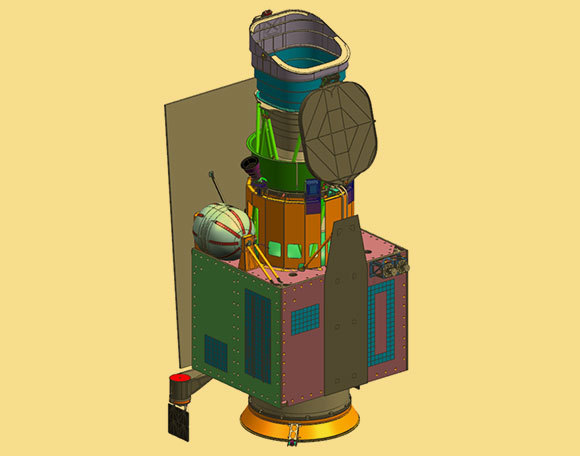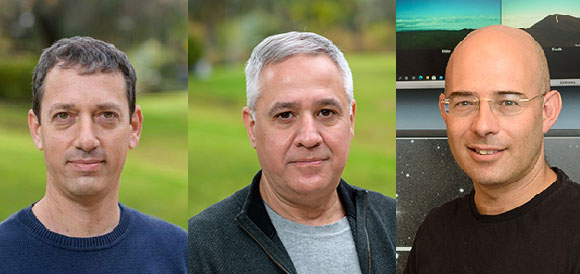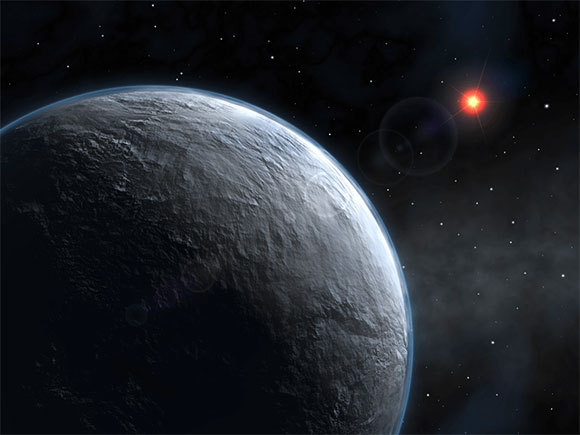ULTRASAT, an innovative space telescope, which is being developed at the Weizmann Institute of Science, will place Israel at the forefront of observational astronomy.
“It is a scientific breakthrough project, that will place Israel at the forefront of astronomical research, establish it as a rising force in the field of scientific satellites and give the Israeli industry an excellent exposure”, says Prof. Eli Waxman, an astrophysicist at the Weizmann Institute of Science, the principal investigator of the ULTRASAT mission and one of the fathers of the first Israeli space telescope, planned to be launched in 2025. “The beautiful thing about this mission is that it is led by science. We set goals that are at the forefront of scientific research, and in order to achieve them we have to be the first and the best”.

A collaboration between academia and cutting edge companies from Israel's technological industry: design diagram of the ULTRASAT Space Telescope
Transient Events and Radiation
The idea of an Israeli space telescope was born more than a dozen years ago, during conversations between Prof. Waxman and Weizmann Institute scientists and Zvi Kaplan, head of the Israeli Space Agency at the time, who strove to promote groundbreaking science that would be based on Israeli satellites. The Israeli team began to discuss the matter with colleagues from the California Institute of Technology (Caltech), reaching the conclusion that the main gap currently existing in observational astronomy is the [in]ability of real-time detection of short-lived cosmic events, such as supernovae or large star explosions, short gamma-ray bursts and neutron star mergers. The only way to study such events, the duration of which can be several weeks or several days, and sometimes even less, is to detect them in real time and point multiple telescopes with different capabilities at them, both on the ground and in space. However, space is vast, and the chances of detecting such an event in real time by random observations are quite slim. Thus, the idea was to launch a space telescope with a wide-field, that is, a telescope that would, at any given moment, capture a relatively large portion of the sky, and would allow its operators to detect such transient events in real time.
The next stage consisted of selecting the type of radiation that the telescope would be able to detect. Stars emit electromagnetic radiation at a range of wavelengths, from X-rays and gamma rays to visible light and radio waves. The researchers eventually decided to choose a telescope that detects ultraviolet (UV) radiation. “There are many wide-field sky surveys, but there are none in ultraviolet radiation”, explains Dr. Yossi Shvartzvald from the Weizmann Institute of Science, ULTRASAT Project Scientist. “This telescope is spearheading real time astronomy. Thanks to the advanced technology and instant communication, within 15 minutes of identifying a transient event by the ULTRASAT telescope, we can determine with high accuracy the event’s location and point more telescopes at it”.
“Ultraviolet radiation is emitted by ‘hot’ astronomical phenomena, including collisions of supermassive cosmic objects, such as black holes or neutron stars, as well as explosions of stars and other events” explains Dr. David Polishook from the Weizmann Institute of Science, the coordinator of scientific communications for the ULTRASAT mission. “We cannot detect this radiation with telescopes on Earth, since it is filtered out by the atmosphere, and we thus have to use a telescope that is located in space”.

Early detection and in-depth study of short-lived and energetic cosmic events. Collision between two neutron stars. Imaging: NASA/Swift/Dana Berry
Weizmann Institute scientists have submitted to NASA (National Aeronautics and Space Administration) several joint proposals for the development of the telescope, together with Caltech scientists, who were to build the satellite’s unique UV camera, later to be joined by NASA’s Jet Propulsion Laboratory (JPL). However, the proposals were not accepted. Eventually, an agreement was reached with the Deutsches Elektronen-Synchrotron (DESY), according to which DESY would provide the camera, which is one of the most expensive components in the telescope, in exchange for assignment of DESY scientists to the telescope’s research teams. The rest of the funding will come from the Weizmann Institute of Science (WIS) and from the Israel Space Agency (ISA), which operates under the auspices of the Israeli Ministry of Science and Technology.
Several cutting edge companies from Israel’s technological sector have joined the complex project, the total cost of which is estimated to be about 100 million dollars. Among these companies are ELOP (Elbit Systems Electro-Optics), owned by Elbit, in charge of building the telescope itself, Tower, who, together with AnalogValue, is responsible for developing the camera's light detectors, which are set to effectively capture UV radiation, and IAI (Israel Aerospace Industries), in charge of the design and construction of the satellite itself and of its computer.

Striving to be the best. Principal Investigator Eli Waxman (center), Project Scientist Yossi Shvartzvald (left) and Science Communications Coordinator David Polishook (right). Photography, Weizmann Institute of Science, Itai Belson
An Innovation to Suit Every Pocket
A space telescope is a telescope mounted on a satellite that orbits the Earth, or in some cases the Sun, such as the James Webb Space Telescope, launched in late 2021. Such telescopes have several important advantages: their activity is not limited to nighttime, they are unaffected by clouds and weather, and most importantly: the satellite is located above the atmosphere, which normally distorts the passage of certain types of radiation and even completely absorbs some types of radiation, such as ultraviolet radiation. “The filtering is essential for the protection of life on Earth, but it is giving astronomers a hard time”, says Polishook.
Along with these advantages, space telescopes also have drawbacks. They are limited in size, can usually operate only for a few years before beginning to malfunction due to the rough environment, and the possibility of repair or maintenance in the case of malfunctions is nearly nonexistent. Another major drawback is their high cost, compared to ground-based telescopes. The cost of developing the James Webb Space Telescope, which also broke records in this field, increased over the years to more than ten billion dollars. ULTRASAT’s budget is only about one percent of that.
"We are proving that it is possible to carry out missions with an achievable budget, and to be at the forefront of science, thanks to correct and innovative telescope design” emphasizes Eli Waxman. “An example of this is the unique structure of the telescope, built by ELOP, as well as the UV sensors, developed in collaboration with the Tower company. The appropriate technology required for building them did not even exist up until a few years ago”. The sensors, which are at the core of the telescope’s optical system, will enable it to detect ultraviolet light in the short range (at wavelengths of 230-290 nanometers), with a much higher sensitivity compared to other UV telescopes. “There are very few substances that transmit ultraviolet light. Together with Tower, we developed several dedicated coatings for optimal filtering of the radiation, we have produced three such [UV transmitting] materials, and based on multiple experiments with them, we developed a light filter consisting of several layers of materials, each of a different thickness, tailored specifically for this purpose” explains Yossi Shvartzvald.

Original development: UV sensors, the technology necessary for building them did not exist up until a few years ago. Technical model for experiments with space telescope sensors Photo: DESY
Collisions and Explosions
Another significant innovation in the telescope is the width of its field of view: 200 square degrees. “For comparison, the diameter of the full moon in the sky is roughly half a degree”, notes David Polishook. “Such a wide field of view allows the telescope to capture a very large part of the sky at every shot”.
ULTRASAT’s main mission is to identify and study those short-lived transient events that occur in the universe. These are events that occur very quickly by astronomical standards, lasting from a few weeks to a few days, hours or minutes. Among these types of events are collisions of exceptionally heavy (supermassive) astronomical objects, such as black holes and neutron stars.
Research into such phenomena has gained momentum in recent years thanks to the ability to detect such events using gravitational wave detectors, notwithstanding the many limitations of such detectors. “Thanks to ULTRASAT’s technology, which combines a wide field of view with depth sensitivity, it can determine, with a precision greater than that of those detectors, the location and distance of such an event”, explains Schwarzvald. “Within 15 minutes of receiving a gravitational wave detector alert we can turn the telescope so as to point towards the event. This allows us to both image the first stages of the event, which involve high emission of ultraviolet radiation, as well as to immediately notify the global astronomical community as to the event’s precise location, which will allow a wide range of telescopes and other measuring systems to be aimed at it. Our data collection and international collaboration will pave the way for a better understanding of the processes that occur during such collisions and of their impact”.
Another group will make use of ULTRASAT’s observations to study the events that occur when a particularly large (‘supermassive’) black hole swallows stars, and in fact tears them apart, in a process that also emits UV radiation that can be detected by the telescope, and through it to better understand the mechanisms underlying the process. Another group will study quasars, celestial bodies that emit large amounts of energy. An additional group, led by David Polishook, will focus on using the telescope to study our solar system, mainly to distinguish between different types of asteroids according to their reflectance of ultraviolet radiation, which reflects their iron content.

Study the explosion quickly before its remains disappear. A simulation model of a supernova - an explosion of a large star | Illustration: NASA
One of the difficulties in studying supernovae is the ability to detect and study these explosions in real time, before their remains disappear. “Large quantities of UV radiation are emitted during these events, mainly during their first stage”, explains David Polishook. “Thanks to its wide field of view, ULTRASAT can detect many of these events, image them sequentially and instruct additional telescopes to be pointed at them. We expect to identify about 250 supernovae per year using ULTRASAT, as well as to be able to monitor the earliest stages of such events, thanks to the sequential imaging. This research will finally enable us to understand the mechanisms of explosions of different types of supernovae and the energy regimes of these processes”.
In its day-to-day operation, in between the measurements of such events, the telescope will be used to survey the sky for objects that emit ultraviolet radiation. It will image the sky every five minutes and gather data regarding millions of stars and other celestial bodies. This will allow the researchers to gather huge amounts of data, and to create a basic map to be used for comparison with newer images, and thus enable quick detection of newly occurring events. Thanks to the high-speed imaging and its high capabilities, the telescope is expected to increase the rate of detection of transient events by 300 fold, and to provide researchers with a goldmine of data for studying many phenomena.

Try to identify planets that may be suitable for living, and characterize the composition of their atmospheres. Model of a planet with an atmosphere in a distant solar system | Source: ESO
The telescope’s extensive scientific team includes dozens of researchers from Israel and from other countries, organized in 13 work teams, in order to take advantage of the telescope's many capabilities. One of these teams, led by Schvarzvald, will explore other solar systems and their planets. “Observations in ultraviolet light will allow us to identify which solar systems may be suitable for life, in terms of the level of radiation emitted by their respective stars”, explains Schvarzvald. “Additionally, we will be able to try to identify new planets outside our solar system, and try to characterize the atmospheric composition of planets in other solar systems”.
Another group will make use of ULTRASAT’s observations to study the events that occur when a particularly large (‘supermassive’) black hole swallows stars, effectively tearing them up, in a process that also emits UV radiation that can be detected by the telescope, and through it better understand the mechanisms underlying the process. Another group will study quasars, celestial bodies that emit large amounts of energy. An additional group, led by David Polishook, will focus on using the telescope to study our solar system, mainly to distinguish between different types of asteroids by their pattern of reflection of ultraviolet radiation, which reflects their iron content.

The new telescope will open a window into the study of a wide range of astronomical phenomena and cosmic events. Model of a star being ripped apart as it is swallowed by a black hole. Illustration: Sophia Dagnello, NRAO / AUI / NSF
Competitive Collaboration
The ULTRASAT telescope will be mounted on a satellite that weighs roughly one ton. About half of the weight is fuel, which will allow it to enter orbit after the launch, at an altitude of 36 thousand kilometers. Objects at this altitude complete a full circle around the Earth within 24 hours, which, naturally, is the time that takes Earth to revolve around itself. This means that such a satellite is constantly hovering above a specific location on Earth, and so it is called a geocentric orbit, meaning “stationary relative to Earth''. Most telecommunication satellites are usually found in such a geostationary Earth orbit, since it allows for constant and continuous communication with ground stations. This is precisely the reason why ULTRASAT will be sent to such a location. From there it will be able to transmit data in real time to the ground station, which will relay the data to the control room currently under construction at the Weizmann Institute of Science. Thus, upon any identification of a significant transient event, it will be possible to direct the telescope at it almost immediately.
The launch of the telescope is scheduled for early 2025. Once it enters orbit, the first months of the mission will be devoted to an initial sky survey, in order to compile a reference map that will allow it to identify future events. The satellite is expected to operate for 3-6 years, providing a wealth of rich scientific information, which will fill many gaps in our knowledge of the universe and its mysteries. At the end of the mission the satellite will use the remainder of its fuel to launch itself into a higher orbit, which will ensure that it will not hit another object nor create additional space debris in the future.
“It will be very exciting to see the images from this satellite. There were many steps along the way where we could have despaired and given up, for example every time that our proposal was not approved, and it took a lot of determination and faith to keep all of our collaborators and carry on”, says Waxman. “It is a very gratifying feeling to have made it this far, and it is going to happen. Almost all of the astronomers in Israel are collaborators on this project, and all of Israel’s astronomy will change as a consequence of it”.

Trying to succeed together to better understand the universe. A model of the ULTRASAT control room (below) and the adjacent visitor center, planned to be established at the Weizmann Institute of Science | Source: Weizmann Institute of Science
“The collaboration on this project is exceptional. It is the largest collaboration of its kind between industry and academia in Israel, and there is also a unique collaboration between the scientists themselves” adds Schwarzvald. “There is plenty of competition between scientists, but we are all trying to succeed together, with the common goal to better understand the universe”
In addition to the space telescope’s scientific mission, it also has an educational mission, led by the Davidson Institute for Science Education, the educational branch of the Weizmann Institute of Science. “I think that the telescope will have a great educational impact”, says Waxman. “ Its extensive exposure will promote science and technology education, help encourage young girls and boys to study science and engineering, and will contribute to expanding the civic space community in Israel”.
Long before ULTRASAT is ready to set out on its historic path, and observe distant places in the universe, Waxman and colleagues are already looking much further. “We are aiming at having an Israeli space telescope in space at all times, and are already thinking of the next project, perhaps a wide field X-ray telescope”’ concludes Waxman. “Israel should launch such a satellite every five years. We will prove that it is possible to achieve this with a budget of this magnitude and move science forward”.
